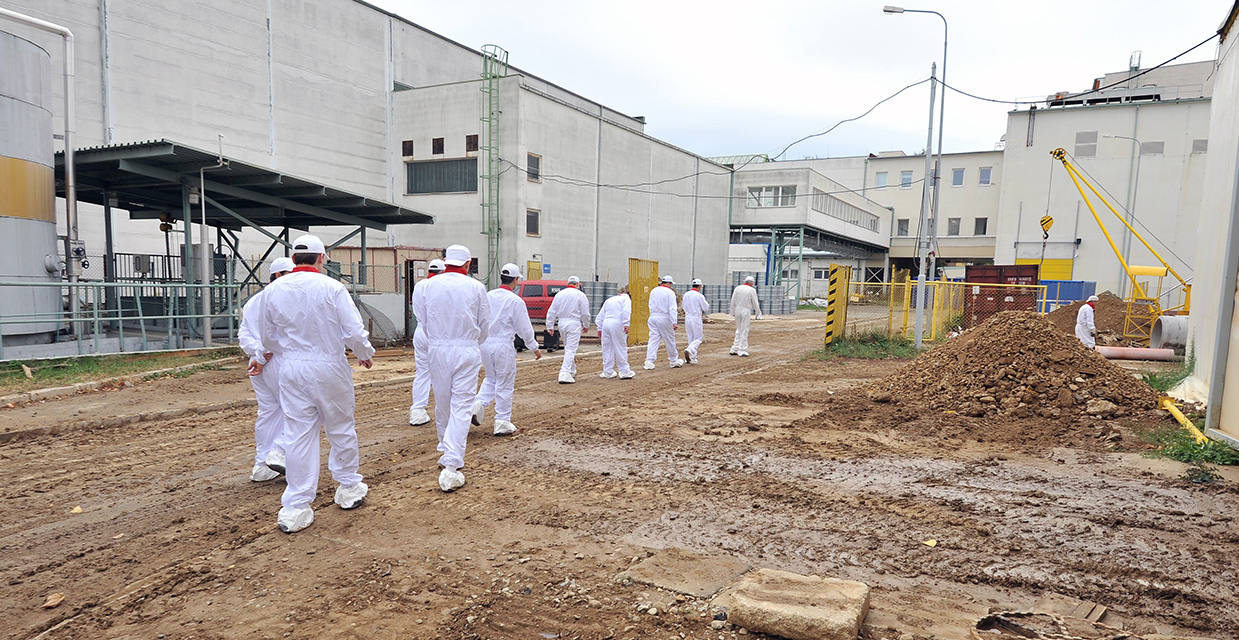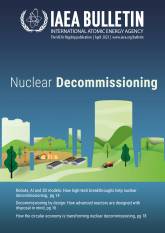
If you would like to learn more about the IAEA’s work, sign up for our weekly updates containing our most important news, multimedia and more.
Slovakia Sets Global Example for Nuclear Power Plant Decommissioning
Michael Madsen

Experts from Georgia, Greece, Hungary, Lithuania, Russia, Slovenia and Ukraine joined a scientific visit to Bohunice nuclear power station in Slovakia in October 2011. (Photo: D. Calma/IAEA)
When Slovakia joined the European Union (EU) in 2004, it did so on an important condition relating to nuclear safety: the country would need to shut down and decommission its V1 reactors at the Bohunice nuclear power plant. These were Soviet-era reactors that were considered to no longer meet the relevant nuclear safety standards of the day. The Slovakian Government made a commitment to decommission the reactors and, in the process, it set an example for others to follow on decommissioning a nuclear power plant safely, efficiently and effectively. With support from the IAEA and the European Commission, Slovakia is now sharing what it has learned in order to benefit other countries.
Slovakia generates a little more than half of its electricity from nuclear energy. The four reactors at the Bohunice site have played a large role in this. The Bohunice V1’s first unit, which started up in 1978, was the site’s first pressurized water reactor using a water cooled, water moderated power reactor (WWER) 440 V230 design. It was one of the earliest versions of ‘water-water energetic reactors’ developed by the Soviet Union. However, there were challenges regarding the containment building’s design, as it was at greater risk of large pipe breaks compared to later buildings that were constructed using improved designs.
Olena Mykolaichuk, Director of the Division of Nuclear Fuel Cycle and Waste Technology at the IAEA, has worked closely with experts from Slovakia’s State-owned Nuclear and Decommissioning Company (JAVYS) as the Bohunice V1 decommissioning project has progressed. “Throughout decommissioning, JAVYS has turned to innovative digital tools to ensure that the process was safe and efficient. These tools are now being adopted by decommissioning projects around the world,” Mykolaichuk said.
Throughout decommissioning, JAVYS has turned to innovative digital tools to ensure that the process was safe and efficient. These tools are now being adopted by decommissioning projects around the world.
The tools that were employed by JAVYS included virtual modelling and simulations. Using simulations, engineers developed procedures to extract the reactor vessel, which was embedded in the concrete reactor shaft, and then to move it and lower it into pools of water where it could be safely cross sectioned using saws for further packaging towards safe storage.
Eva Hrasnova, a project manager at JAVYS, said that the project showed that mechanical cutting tools, such as band and circular saws used underwater, were safe and productive ways to fragment the radioactive primary circuit components of WWER-440 reactors. She also said that the experience showed that a combination of decontamination methods — chemical, electrochemical and ultrasonic, as well as mechanical methods such as blasting and grinding — proved to be crucial for the follow-up effective waste management.
“The Bohunice V1 decommissioning uncovered a host of practical insights for decommissioners,” said Mykolaichuk. “From determining ways to save space and money by reusing buildings for storage, to recycling a high degree of steel, metals and concrete so as to support circular economy principles.”
The decommissioning of Bohunice V1 is ongoing and is expected to continue until 2027. With financial support from the EU and the European Bank for Reconstruction and Development, the project’s final bill is expected to reach €1.239 billion.
In recognition of the achievements made by JAVYS in decommissioning Bohunice V1, and in order to further strengthen the implementation of similar projects around the world, the company was designated an IAEA Collaborating Centre in March 2021. Consequently, as a Collaborating Centre for nuclear facility decommissioning and radioactive waste management, JAVYS has been able to share its experiences with others, in coordination with the IAEA.
“In Bohunice we can effectively demonstrate technical progress and safety in physical and radiological characterization, decontamination, dismantling, demolition and associated waste management,” said Pavol Štuller, Chief Executive Officer of JAVYS, at the Collaborating Centre’s signing ceremony, which was held in Vienna, Austria. “Our cooperation with the IAEA is centred on implemented and planned work, and will be further enhanced as the Collaborating Centre progresses over the coming years.”
The partnership between the IAEA and JAVYS is already bearing fruit, and the IAEA held the International Workshop on Lessons Learned from the Implementation of Decommissioning Projects for Water Cooled, Water Moderated Power Reactors in Trnava, Slovakia, in May 2022. At the workshop, experts from JAVYS shared the company’s decommissioning insights with experts from Armenia, Belgium, Bulgaria, China, the Czech Republic, Finland, Hungary, Italy, Norway, Türkiye and Uzbekistan as well as representatives of EBRD and EC.
“Some of these countries currently operate WWER reactors and are planning for their decommissioning, while others are embarking on nuclear power programmes or building nuclear facilities and are already considering their long-term decommissioning requirements,” said Mykolaichuk. “We are seeing the emergence of more responsible and forward-looking nuclear activities, where decommissioning and its challenges are considered from the beginning. These activities are strengthened by the lessons from the efforts by JAVYS at Bohunice V1.”






